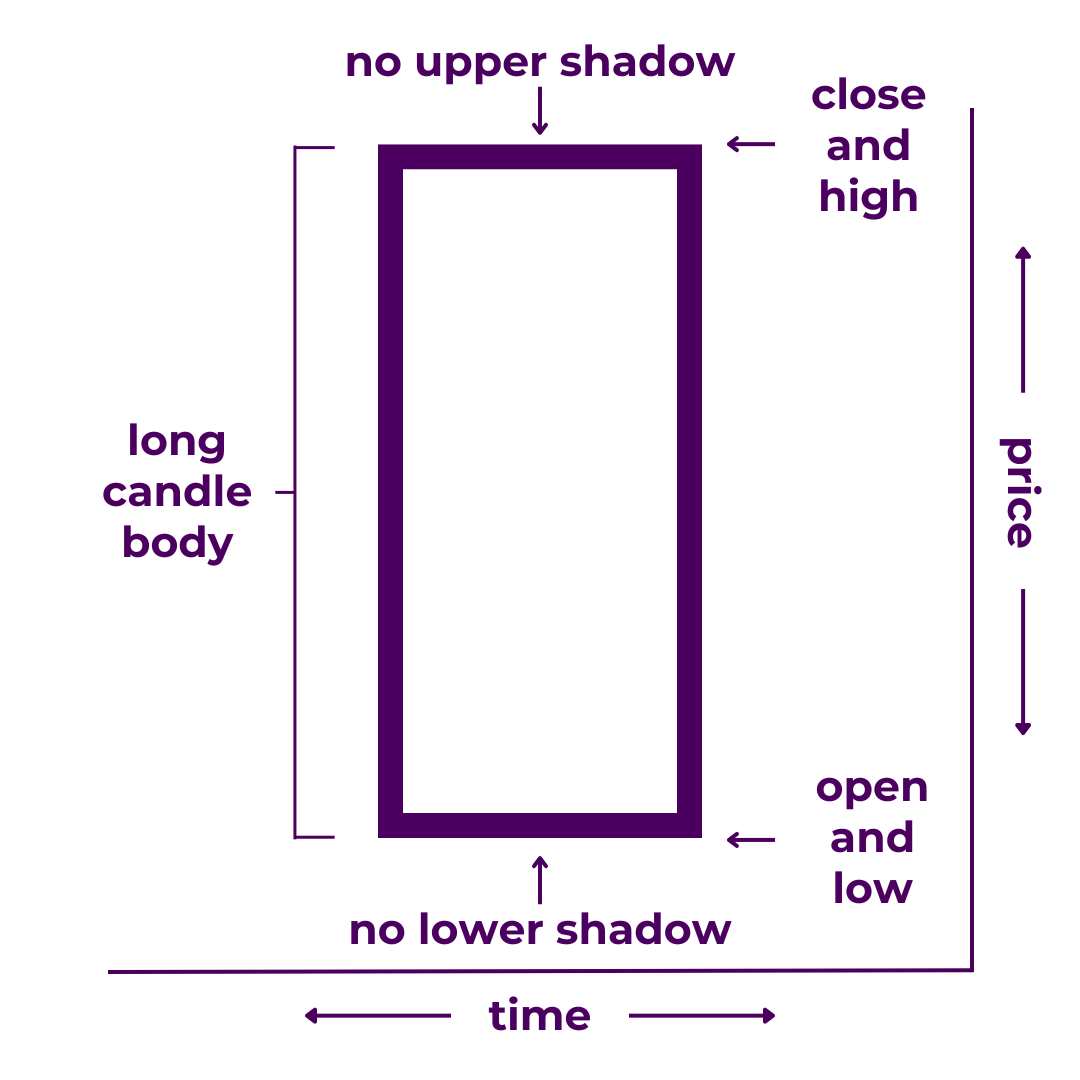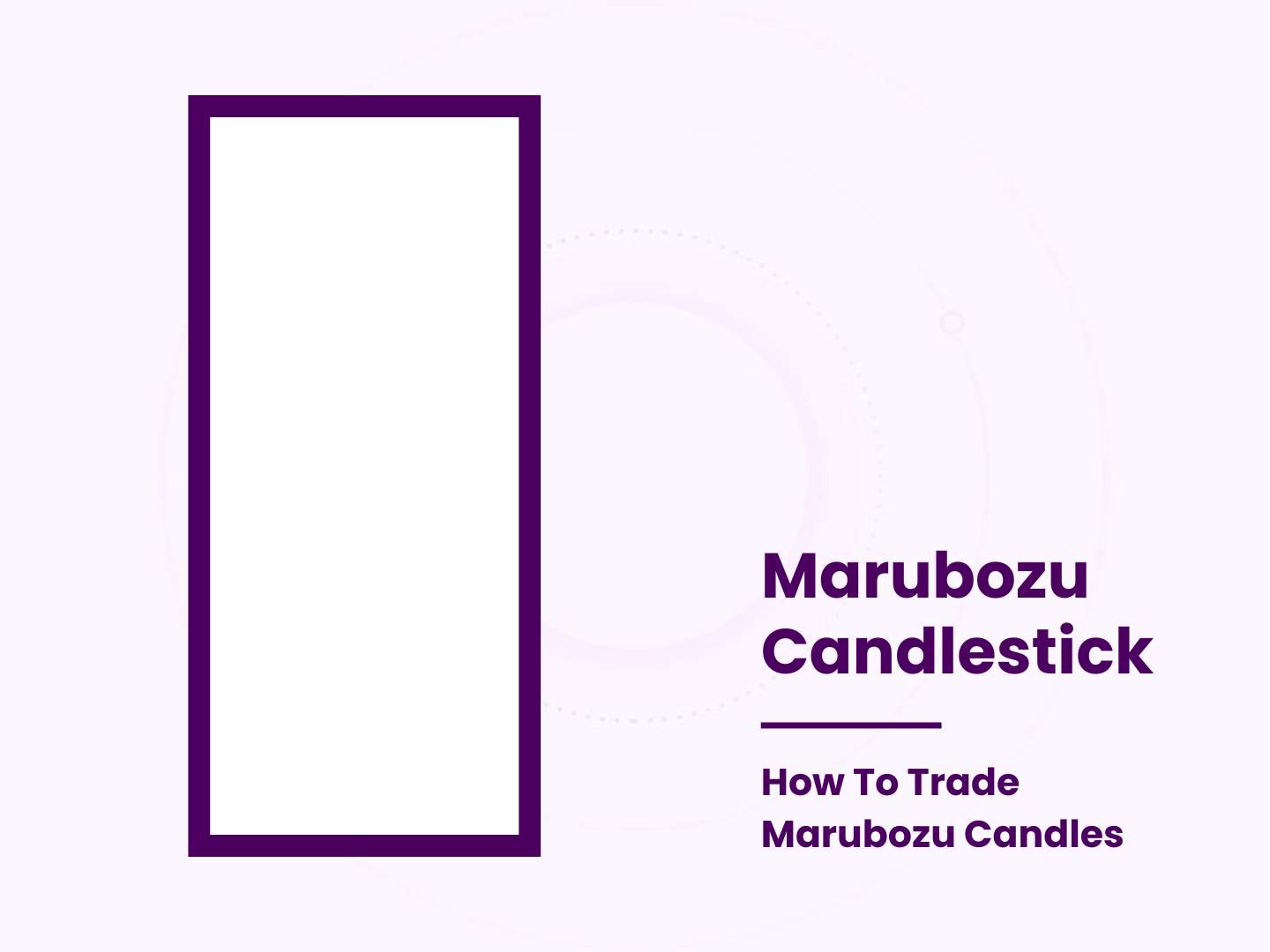Marubozu candlesticks are one of the most famous types of candlesticks for good reason.
Japanese candlesticks are the basic building block of most technical analysis. That makes the ability to recognize different candlestick types a crucial trading skill.
In this Guide to Marubozu Candlesticks, we’ll explain:
First though, let’s start with a definition.
What Is a Marubozu Candlestick?
A marubozu is a long candlestick without shadows. It indicates that the open and close prices are the same as the high and low prices (or vice versa), and cover a large trading range. Marubozu candlesticks are commonly seen in trending moves, reversals, and intervals of peak volatility.

Marubozu means “shaved head” or “close-cropped” in Japanese. This comes from the lack of wicks, making the candle look “bald.” In trading terms, a marubozu candle signals dominance.
A marubozu candlestick paints a picture of overwhelming momentum. On the chart, it looks like non-stop price movement for an entire period. Without any wicks, the color of the candle always stands out. Bullish marubozu scream, “To the mooooon!” Bearish ones wail, “Going Doooown.”
Technically, marubozu shouldn’t have any wicks at all. However, “perfect” marubozu are comparatively rare. If the wicks are insignificant, you can basically treat it like a marubozu. All types of long candles have roughly the same implications anyway.
When it comes to trading candlesticks, context is always more important than exact criteria.
More on how to trade marubozu candles in a moment.
First, let’s illustrate how they are formed.
How Are Marubozu Candles Formed?
Marubozu give the impression of one-way price action.
However, that is not always how it plays out.
Within the time period of the candle, price action is often more volatile than the marubozu may make it seem. For example, a bullish marubozu on a daily chart shows that the bulls won the day, but they may not have been in control all day. You’d need shorter timeframes to see a more complete picture.
That’s also why you should usually wait for confirmation. It’s not officially a marubozu until the candle closes. And it can be dangerous to make trades based on incomplete candles.
You can never be 100% sure how a candlestick will look at the end of the time period.
That’s one of the reasons it’s so important not to get too focused on any single candle.
Where Marubozu Candlesticks Fit in the Chart Narrative
The markets are often characterized as a battle between the bulls and the bears.
Marubozu indicate that one side is clearly winning (or at least won over the time period that candle represents). Obviously, no single candlestick can determine an entire trend. Still, marubozu that appear at the right time can be decisive.
Be on the lookout for them during:
- Trending Moves – Marubozu may be most common during heavily trending moves, especially “exponential” ones.
- Reversals – Marubozu candlesticks occasionally appear in certain reversal patterns, like the bullish engulfing.
- Volatile Periods – When volatility and indecision mix, you may get marubozu, as seen in stick sandwich patterns.
They may also appear in certain types of candlestick patterns.
To become a successful trader, understanding candlesticks is a great place to start. But you should also learn how candlestick patterns and chart patterns work. Plus, you need to be able to recognize cycles, trends, and price levels. From there, you can begin to read the story in the charts.
Tools like chart markup and trading indicators can reveal even more. And once you’ve chosen your asset(s) and trading style, the full chart narrative truly comes into focus. The charts will basically speak to you at this point.
By looking at the history of the chart, you can identify how price action played out around prior marubozu candles (or patterns that included them). Moreover, you can compare historical structures in price and your other tools to current price action.
Now, you’re actually doing real technical analysis.
How To Trade Marubozu Candles
You should never trade based on a single candlestick.
However, certain candle shapes may give you some trading ideas, especially given the right context. Marubozu candlesticks are one of those shapes.
In addition to the overall structure surrounding a marubozu, there are some other things worth paying attention to.
- Trading Volume – The greater the trading volume during any candlestick’s formation, the greater its potential implications on future price action.
- Candle Size – Larger candles often signify important changes to market conditions, such as shifting support and resistance.
- Price Formations – The open and/or close of marubozu candles may help establish the strength of price levels and trend lines.
- Breakouts – Market phases often come to a close with powerful price action that includes dramatic-looking candles like marubozu.
Generally, the fewer of these factors that are present, the less noteworthy the candle. Additionally, when looking at time periods where marubozu are common (ie. the 1-minute chart of a volatile asset), you should usually give their appearance less weight in your analysis.
In order to form a complete trading strategy, you need to understand the basic math of trading, order types, and trading psychology. Even more importantly, you need to develop your own edge and learn risk management. And if you really want to take it all the way, look into options and trading automation.
Before you get there though, there’s still more to learn about the candles themselves.
Other Types of Candlesticks
The marubozu candlestick is but one of many candlestick types.
You’d be wise to get familiar with all of the other ones too.
- Bearish Belt Hold
- Bullish Belt Hold
- Doji
- Dragonfly Doji
- Gravestone Doji
- Hammer
- Hanging Man
- Inverted Hammer
- Long Candle
- Long-Legged Doji
- Shooting Star
- Spinning Top
Not all candlesticks shapes earn names. So you should probably check out the ones that do. Just keep in mind that it’s not necessarily about memorizing all of the ins-and-outs of each. It’s more about ingraining the principles of price action into your brain.
In fact, you’re free to forget all of the names as long as you can look at a candlestick and understand what it means.
Takeaways
To review:
Marubozu candlesticks are a type of candlestick that signals dominance for either the bulls or the bears. They tend to show up during trending moves, reversals, and periods of high volatility. That means they can help you find winning trades.
Of course, there are other types of candlesticks that you should learn about. And even so, candlestick analysis alone is not enough to trade successfully.
Nonetheless, you’ve now added one more tool to your toolkit.
Have questions or more information to add? Contribute to the conversation in the comments below! Or, if you know someone who could benefit from this post, share it with them. You can also check out our Japanese Candlesticks Guide to improve your candlestick analysis skills.


0 Comments